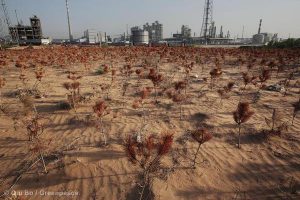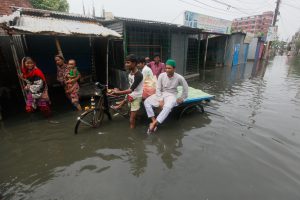There is increasing evidence that China is undergoing climate change. The boundaries of climate zones are shifting, as are the pattern of the seasons. These phenomena are accompanied by more frequent natural disasters, such as cyclones, snowstorms and floods. This causes water and energy shortages, puts pressure on urban infrastructure, generating health concerns and leading to serious economic losses.
To cope with these challenges, the Chinese government set up a policy framework and adopted policies to tackle vulnerability caused by climate change. In 2008, a specialised central government department (the Department of Climate Change) was set up under the National Development and Reform Commission.
Since 2008, an annual White Paper on policies and actions has been published, reviewing policies and setting new goals. The most recent document is the 2011 Chinese Climate Change Policy and Action, which laid out the plan for 2011−2016 and in which there is a section on adaptation to climate change.
Dedicated funding has been allocated for research on reducing carbon dioxide emissions and understanding climate change. In the Eleventh Five-Year Plan period (2006−2010) seven billion yuan (US$ 11 million) was allocated, funding 288 research centres and 91 research labs.
Efforts to get local governments (provincial and municipal levels) involved started in 2008, and by the end of 2010, each province had drawn up its own climate change adaptation plan. Good local initiatives are supposed to be piloted, and the successful ones rolled out nationwide.
Some specific measures include:
In areas of water shortage, such as Guizhou and Yunnan provinces, the local government took the initiative to explore groundwater sources to maintain water supply. In some western and central provinces where areas have become uninhabitable because of frequent droughts, migration projects have been introduced, including housing, re-employment, infrastructure and basic services.
To reduce the impact of extreme weather, the government has also invested in weather forecasting services to help people understand climate change and is distributing information on preventive methods and self-protection against extreme weather conditions.
To reduce high temperatures in urban areas, campaigns were introduced with the aim of increasing green space in cities (and also to improve air quality). Urban development and regeneration removed some properties at risk, such as old dilapidated houses in areas at risk of flooding during storms. In addition, roof gardens have been proposed as a way of reducing the urban heat island effect in cities. Local governments, such as those of Beijing, Shanghai, Hangzhou, Shenzhen, Changsha and Guangzhou, have also introduced their own planning policies to build roof gardens.
GDP takes priority
Despite these efforts to strengthen the policy framework and increase local participation, the current system automatically leads to poor implementation of policies. Whilst it might seem as if climate change is moving higher up the local government agenda, in reality localised policy-making tends to treat central government mandates as guidelines to be manipulated to serve their own interests. As a result, projects can be hijacked by local governments for business interests or in pursuit of increasing their GDP.
A policy process that is in theory evidence-based (“experiment first – scale up later”) is in fact limited by a focus on success. Failed pilots are generally ignored; little effort is made to examine what could be done to fix the problems. Unsuccessful projects are often simply dropped.
Policy-makers need to understand better the human, social and economic costs of climate change, beyond simple measures of GDP loss and the human impact of the policies adopted.
The policy-making process largely excludes local residents and smaller businesses that might be affected.
Greater efforts to engage social scientists, NGOs and the general public in decision-making and post-project assessment is crucial to the viability of genuinely evidence-based policy-making and adjustment.
Within the government system, there are also large differences between local governments. This reality, along with large variations in the scale and prosperity of different localities and different understandings of the relevant issues, means that local governments’ capacity and incentive to engage can vary greatly.
To improve the framework, it is important to find ways of aligning local and central interests. One frequently called for approach would be to reform the assessment of local governments’ achievements so that they would not be inclined to focus climate change adaptation on GDP growth only. However, unlike GDP growth, climate change adaptation can hardly be measured by a single indicator.
You can view a a full version of the paper: ‘Governing urban climate change adaptation in China‘




